Name: The Yoshino cherry is one of the best known and most admired of the Japanese flowering cherry trees. It is widely grown in its native Japan and in many countries of temperate climate worldwide.
Botanical name: The botanical name of the Yoshino cherry is Prunus x yedoensis. Prunus is the botanical name for the genus that includes cherries and plums. The second part of the name refers to Edo, an old name for Tokyo, and the hybridisation between two species native to Japan has taken place in an area to the west of Tokyo. The x letter between the generic and specific names signifies that this plant is a hybrid between species, namely Prunus speciosa and Prunus subhirtella.
The first mentioned species has relatively large white flowers, while the second kind has an arching habit of growth and is known as the winter-flowering cherry because it flowers occasionally in mild winter weather with light pink flowers. The specific name subhirtella means less hairy, considered to be a reference to the flower stems. There is a pendulous form ‘Pendula’ but it flowers relatively poorly.
Family: The genus Prunus is part of the rose family, the Rosaceae. This is a very large family with many plants of gardening and horticultural merit. Typically, the flowers of its member plants have flat or lightly cupped flowers with five relatively broad petals.
Garden value
The Yoshino cherry has immense garden value, resulting in its great popularity and widespread planting. It is noted for its relatively early flowering, not the earliest, but still ahead of most of the Japanese flowering cherries. It flowers reliably in March each year, starting usually a few days ahead of mid-month, and lasting three weeks, and a bit more.
The flowers are beautifully shaped, with rounded petals that have a shallow indentation at the outer edge, opening from pink buds inherited from the subhirtella parent and fading to white as they mature, a feature inherited from the other parent. The flowers are scented with light, sweet fragrance, each flower bud carrying about five flowers carried on pretty arched stems that gives the flower display a delightful, characteristic liveliness.
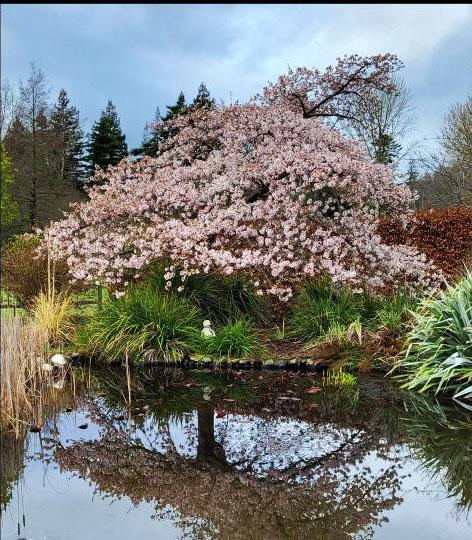
Gerry takes a look at the Japanese flowering cherry tree
The trees themselves have a characteristic shape, spreading and partly pendulous. This variety of cherry, like many others, is usually top-grafted at about 1.5 metres and the crown of mature trees is about another three metres high and four or five metres across. The tree canopy is high enough to allow some light to penetrate its area of shadow and shade-tolerant plants, such as hellebore, Epimedium and Solomon’s seal can be grown.
Although the Yoshino cherry is much admired in an informal fashion in many parts of the world, it is formally viewed in its native Japan. The viewing is a celebration of the spring flowering but also of its delicacy, vulnerability, and its fleeting nature, symbolic of the speed of life.
Growing Yoshino
This cherry is easy to grow and not prone to disease or pests, although bullfinches can do damage locally. Some specimens develop a form of witch’s broom which causes the proliferation of leafy shoots at the expense of flowers but these distinctive growths are easily pruned out, when noticed in early summer. Any ordinary soil will do, either acidic or limy, reasonably heavy, but not wet in winter. It can tolerate substantial wind exposure. After flowering has finished, the foliage is quite handsome and turns to good yellow and orange autumn leaf colour.
Weed control in vegetables
Weed control is one of the most important facets of growing vegetables. There are about 20 weed species that appear commonly or less commonly in a kitchen garden. These wild plants have adapted to compete successfully with other plants by germinating rapidly and becoming established quickly. It is therefore necessary to act quickly to control competitive weeds before they get established when the effort involved takes more time. This campaign of control might begin before the vegetable seedlings appear, the weed species largely being quicker to germinate. This is especially true in a relatively cold spring, such as this year.
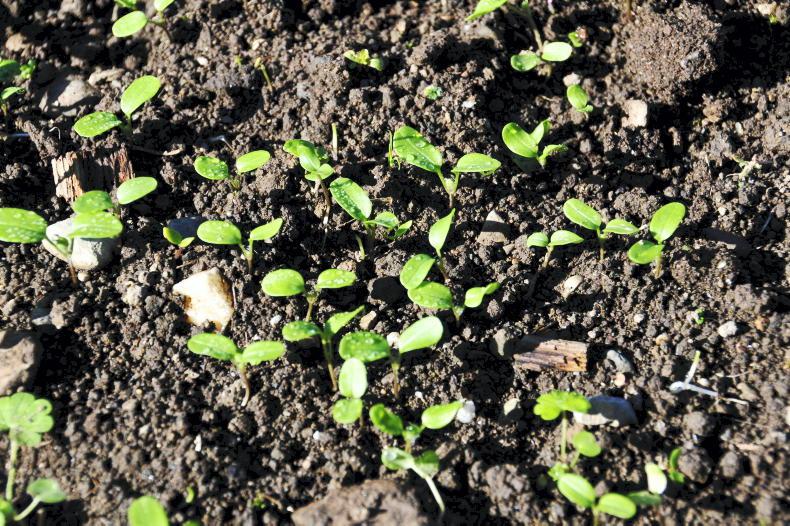
Don't mistake vegetable seedlings for weed seedlings.
If weed seedlings have begun to germinate before vegetables, it is advisable to run a light hoe between the rows of seedlings and to do so when the vegetable seedlings have appeared at the same time as weed seedlings. It is easy to discern which are vegetable seedlings because they will appear in the rows in which they have been sown. The first flush of weed seedlings is generally the heaviest and careful action at the early stage can give excellent results and allows the grower to stay ahead of subsequent generations of weed seedlings. Hoeing is an easy method for weed control between rows of vegetable species, with hand-weeding within the rows themselves. Weeding within the rows can be combined with thinning when that process is carried out with vegetables such as carrots, lettuce, beetroot, summer turnips and parsnips.
Good weed control can be achieved when seedling vegetables are raised in cell trays in the glasshouse or polytunnel. This has to be done with frost-tender vegetables, such as sweetcorn, runner beans, pumpkins, butternut squash and marrows. It is easier to work around larger, better-established plants. This technique can be used for other vegetables that are frost-hardy and can be sown in cell trays or in the open ground in a well tilled seedbed. This includes cabbage, cauliflower, green broccoli, onions, French beans and even peas and broad beans when sown early.
Flowers
Gladiolus and dahlias can be planted directly outdoors from the middle of April. Wait for a while in the colder localities. Lilies can also be potted up for summer flowers. It is too late to sow bedding flowers because they will flower very late. Wait and buy plants in May.
Fruit, vegetables and herbs
Although soil conditions were very good for two weeks or so, the low soil temperatures were not ideal and it has been very wet in March. Slow progress with germination occurs when the soil is so cold, although it is amazing what a few warm days can do. Potatoes and onion sets can be put in now.
Trees, shrubs and roses
The season was very late, no sign of bud break on most trees by mid-March, not even horse chestnut which is usually one of the first. Evergreens, both broad-leaved and coniferous, both can be planted from now on as the sap begins to rise and they will root quickly.
Lawn
Mowing is delayed because ground has become wet again but should be carried out as soon as conditions allow. Use lawn moss killer if there is heavy moss growth. If new areas of lawn are to be sown, the ground should be cultivated about now if possible. Sow lawn seed as soon as conditions are suitable.
Greenhouse and house plants
Sow seeds of sweet peppers and chilli peppers in a warm place and move them to the greenhouse when they germinate. If there is a delay past mid-April, it would be better to wait and purchase plants. Feed and water heavily all greenhouse plants, if not already done.
Read more
Spring forward: time to sow main crop vegetables and look at laurustinus
Paper bush: fragrance for your garden
Name: The Yoshino cherry is one of the best known and most admired of the Japanese flowering cherry trees. It is widely grown in its native Japan and in many countries of temperate climate worldwide.
Botanical name: The botanical name of the Yoshino cherry is Prunus x yedoensis. Prunus is the botanical name for the genus that includes cherries and plums. The second part of the name refers to Edo, an old name for Tokyo, and the hybridisation between two species native to Japan has taken place in an area to the west of Tokyo. The x letter between the generic and specific names signifies that this plant is a hybrid between species, namely Prunus speciosa and Prunus subhirtella.
The first mentioned species has relatively large white flowers, while the second kind has an arching habit of growth and is known as the winter-flowering cherry because it flowers occasionally in mild winter weather with light pink flowers. The specific name subhirtella means less hairy, considered to be a reference to the flower stems. There is a pendulous form ‘Pendula’ but it flowers relatively poorly.
Family: The genus Prunus is part of the rose family, the Rosaceae. This is a very large family with many plants of gardening and horticultural merit. Typically, the flowers of its member plants have flat or lightly cupped flowers with five relatively broad petals.
Garden value
The Yoshino cherry has immense garden value, resulting in its great popularity and widespread planting. It is noted for its relatively early flowering, not the earliest, but still ahead of most of the Japanese flowering cherries. It flowers reliably in March each year, starting usually a few days ahead of mid-month, and lasting three weeks, and a bit more.
The flowers are beautifully shaped, with rounded petals that have a shallow indentation at the outer edge, opening from pink buds inherited from the subhirtella parent and fading to white as they mature, a feature inherited from the other parent. The flowers are scented with light, sweet fragrance, each flower bud carrying about five flowers carried on pretty arched stems that gives the flower display a delightful, characteristic liveliness.

Gerry takes a look at the Japanese flowering cherry tree
The trees themselves have a characteristic shape, spreading and partly pendulous. This variety of cherry, like many others, is usually top-grafted at about 1.5 metres and the crown of mature trees is about another three metres high and four or five metres across. The tree canopy is high enough to allow some light to penetrate its area of shadow and shade-tolerant plants, such as hellebore, Epimedium and Solomon’s seal can be grown.
Although the Yoshino cherry is much admired in an informal fashion in many parts of the world, it is formally viewed in its native Japan. The viewing is a celebration of the spring flowering but also of its delicacy, vulnerability, and its fleeting nature, symbolic of the speed of life.
Growing Yoshino
This cherry is easy to grow and not prone to disease or pests, although bullfinches can do damage locally. Some specimens develop a form of witch’s broom which causes the proliferation of leafy shoots at the expense of flowers but these distinctive growths are easily pruned out, when noticed in early summer. Any ordinary soil will do, either acidic or limy, reasonably heavy, but not wet in winter. It can tolerate substantial wind exposure. After flowering has finished, the foliage is quite handsome and turns to good yellow and orange autumn leaf colour.
Weed control in vegetables
Weed control is one of the most important facets of growing vegetables. There are about 20 weed species that appear commonly or less commonly in a kitchen garden. These wild plants have adapted to compete successfully with other plants by germinating rapidly and becoming established quickly. It is therefore necessary to act quickly to control competitive weeds before they get established when the effort involved takes more time. This campaign of control might begin before the vegetable seedlings appear, the weed species largely being quicker to germinate. This is especially true in a relatively cold spring, such as this year.

Don't mistake vegetable seedlings for weed seedlings.
If weed seedlings have begun to germinate before vegetables, it is advisable to run a light hoe between the rows of seedlings and to do so when the vegetable seedlings have appeared at the same time as weed seedlings. It is easy to discern which are vegetable seedlings because they will appear in the rows in which they have been sown. The first flush of weed seedlings is generally the heaviest and careful action at the early stage can give excellent results and allows the grower to stay ahead of subsequent generations of weed seedlings. Hoeing is an easy method for weed control between rows of vegetable species, with hand-weeding within the rows themselves. Weeding within the rows can be combined with thinning when that process is carried out with vegetables such as carrots, lettuce, beetroot, summer turnips and parsnips.
Good weed control can be achieved when seedling vegetables are raised in cell trays in the glasshouse or polytunnel. This has to be done with frost-tender vegetables, such as sweetcorn, runner beans, pumpkins, butternut squash and marrows. It is easier to work around larger, better-established plants. This technique can be used for other vegetables that are frost-hardy and can be sown in cell trays or in the open ground in a well tilled seedbed. This includes cabbage, cauliflower, green broccoli, onions, French beans and even peas and broad beans when sown early.
Flowers
Gladiolus and dahlias can be planted directly outdoors from the middle of April. Wait for a while in the colder localities. Lilies can also be potted up for summer flowers. It is too late to sow bedding flowers because they will flower very late. Wait and buy plants in May.
Fruit, vegetables and herbs
Although soil conditions were very good for two weeks or so, the low soil temperatures were not ideal and it has been very wet in March. Slow progress with germination occurs when the soil is so cold, although it is amazing what a few warm days can do. Potatoes and onion sets can be put in now.
Trees, shrubs and roses
The season was very late, no sign of bud break on most trees by mid-March, not even horse chestnut which is usually one of the first. Evergreens, both broad-leaved and coniferous, both can be planted from now on as the sap begins to rise and they will root quickly.
Lawn
Mowing is delayed because ground has become wet again but should be carried out as soon as conditions allow. Use lawn moss killer if there is heavy moss growth. If new areas of lawn are to be sown, the ground should be cultivated about now if possible. Sow lawn seed as soon as conditions are suitable.
Greenhouse and house plants
Sow seeds of sweet peppers and chilli peppers in a warm place and move them to the greenhouse when they germinate. If there is a delay past mid-April, it would be better to wait and purchase plants. Feed and water heavily all greenhouse plants, if not already done.
Read more
Spring forward: time to sow main crop vegetables and look at laurustinus
Paper bush: fragrance for your garden







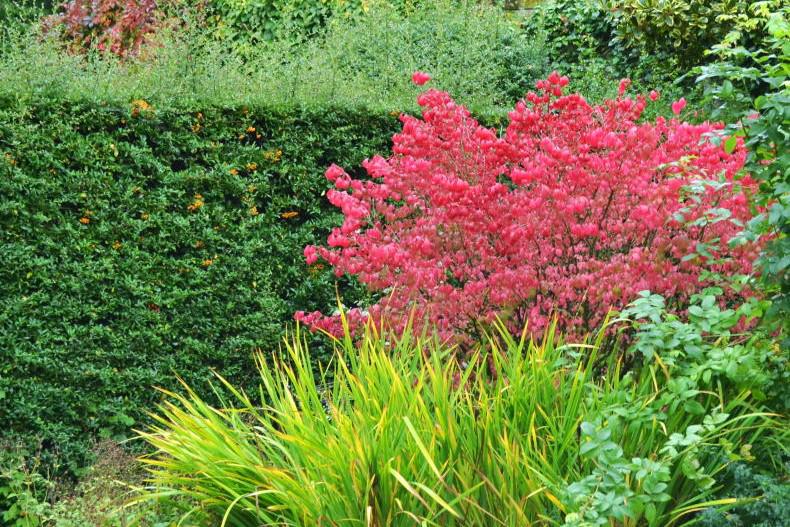
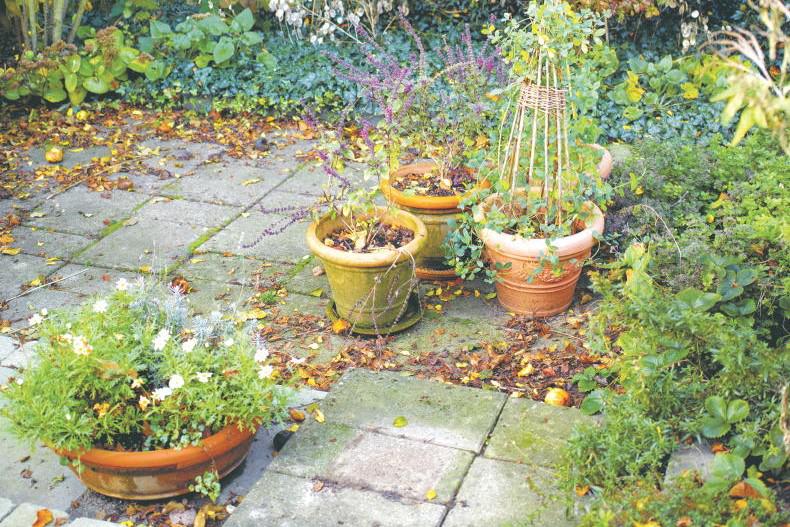

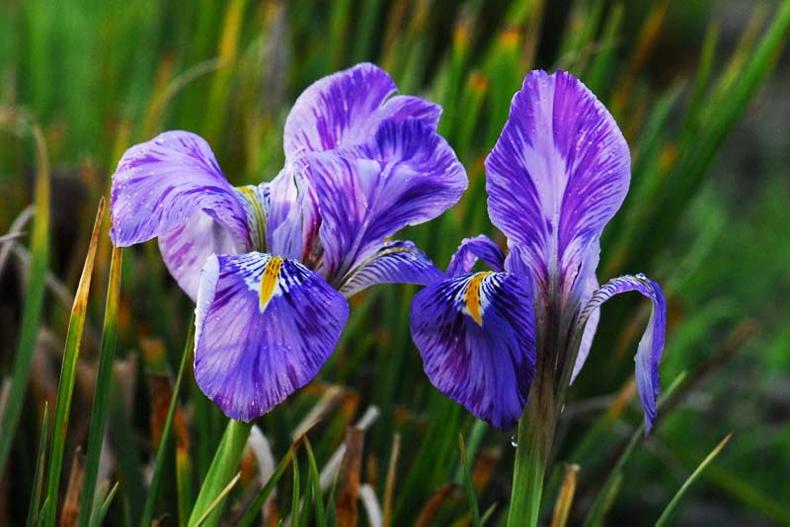
SHARING OPTIONS